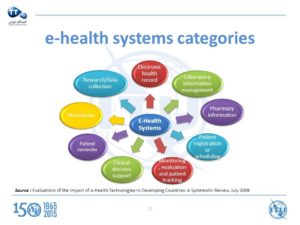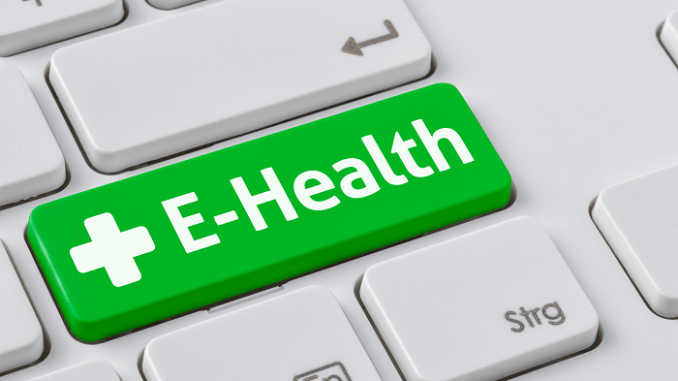
Table of Contents
What is eHealth?
- eHealth refers to the use of internet and other technologies in the health care industry.
- Simply understanding, eHealth is the transfer of health resources and health care by electronic means. It is the healthcare supported by electronics, informatics and tele-communications.
- eHealth can be defined as delivery of health care using modern electronic information and communication technologies when health care providers and patients are not directly in contact and their interaction is mediated by electronic means.
- World Health Organization (WHO) defines, eHealth as “the cost-effective and secure use of information and communications technologies in support of health and health-related fields, including health-care services, health surveillance, health literature, and health education, knowledge and research.”
- In a broader sense, the term eHealth exemplifies/illustrates the technical progress to expand health care locally, countywide, and universal by using information and communication technology.
- eHealth encompasses all sorts of electronic health data exchange such as Telemedicine, Tele-health etc.
- eHealth also characterizes technological commitment towards global health care action.
- eHealth is a cost effective method method of providing health services to the people.
- Examples of eHealth include communication with health care professional via email, access medical records, research health information, etc.
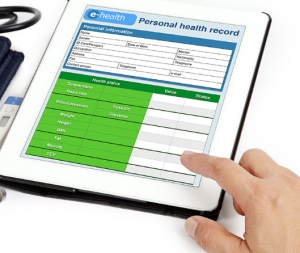
According to World Health Organization (World Health Organization, n.d.) three main core areas of eHealth are:
- Delivery of health information, for health professionals and health consumers, through the Internet and telecommunications.
- Using the power of IT and e-commerce to improve public health services, e.g. through the education and training of health workers.
- The use of e-commerce and e-business practices in health systems management.
History of eHealth
- Traditionally, health care providers kept paper records on the history and status of their patients.
- But with rise in the health care cost and technological advancement, it has encouraged the development of electronic tracking system.
- Thus the concept of digital health or eHealth emerged to designate the use of information and communication technologies (ICT) in the healthcare sector
- eHealth is an evolving field in the juncture of medical informatics, public health, and business, stating to the health services and information distributed or heightened through the internet and associated technologies.
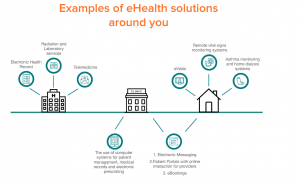
Characteristics of E-health:
The ‘e’ in the eHealth doesn’t just mean ‘electronic’ but represents a number of e’s that characterize what eHealth is all about. The characteristics of e-health or what e-health should comprise of, can be illustrated in following 10 e’s. The 10 e’s of “e-health” (adopted from Eysenbach, 2001) are:
1. Efficiency
- One of the assurances of e-health is to upturn efficiency in health care, thus reducing costs.
- It ensures efficiency in health care with reduction in cost.
- Efficiency is achieved through avoiding duplicative or unnecessary diagnostic, decreasing overhead cost in practice and involving patients for improving communication.
2. Enhancing the quality of care
- Increasing efficiency refers to not only decreasing costs but also improving quality of services.
- eHealth may improve the quality of health care by allowing comparisons between diverse providers.
- It will also focus on quality assurance, aiming patient streams to the finest quality suppliers.
3. Evidence-based
- E-health interventions must be evidence-based in the sense that their value and competence should not be presumed but proven by laborious scientific assessment.
- Much work is still left to be done in this sector.
4. Empowerment of consumers and patients
- eHealth incorporates expanding patients knowledge and access of personal electronic records over the internet
- This unseals new opportunities for patient-centered medicine and facilitates evidence-based patient choice.
5. Encouragement
- Encouragement of patients participation through more proactive care.
- E-health provides encouragement for a new link between the patient and health expert, towards a true corporation, where choices are made mutually.
6. Education
- For both patient and providers it is platform to expand knowledge through researches or health care information.
- eHealth helps to educate physicians and consumers through online sources (ongoing medical education and other resources)
7. Enabling
- Creation of environment for easier exchange of information and easy communication between the consumer and the service provider
- eHealth promotes information discussion and communication between health care institutions in a consistent way .
8. Extension
- E-health extends opportunity of health care further than its conservative boundaries.
- This is meant in both a topographical sense along within a conceptual sense.
- E-health also facilitates consumers to effortlessly achieve health services online from international providers.
- These facilities can range from simple advice/suggestions to more compound intermediations or medications.
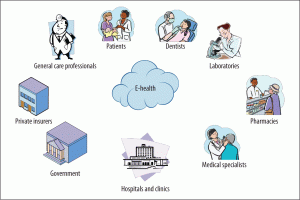
9. Ethics
- E-health includes new forms of patient-physician communication, poses new challenges, and pressures to ethical issues
- For example: online professional practice, informed consent, privacy and equity issues.
- It is one of the pressing issue that poses threat to eHealth.
10. Equity
- Despite clear gap between the ‘haves’ and ‘have not’, equity is one of the promises made by eHealth.
- To make health care further justifiable/fair is one of the assurances of e-health, but at the same time there are substantial risk that e-health might expand the gap between the “haves” and “have-nots”.
- E-health is and should be equitably accessible to all the people, irrespective of their age, race, gender, ethnicity etc.
- People, whose economic conditions are poor, people who lack skills, and access to computers and networks, cannot use computers efficiently. As a result, these patient populations (which would truly value the utmost from health information) are those who are the least expected to benefit from developments in information technology, except political trials ensure equitable access wholly. The digital gap presently runs between rural vs. urban inhabitants, rich vs. poor, young vs. old, male vs. female people, and among the neglected/rare vs. common illnesses.
Scope of eHealth in Developing Countries
- eHealth has been broadly regarded as an opportunity for marked improvement in the public sector in developing countries.
- As developing countries are confronted with health-related problems, eHealth can be a sector for development of whole country.
- The strategic advantage is relevant to the developing countries where the access is limited due to various reasons.
- The tools of eHealth can lead to improve the quality and efficacy of healthcare services.
- Government in the developing nations are keeping eHealth in their priorities to bring improvement in quality, accessibility and capability of health sector.
- Patients and physician are encouraged to use eHealth technologies in effective ways to improve health care.
- eHealth can reduce the cost even in the emergency where resources shortage takes place.
Examples of eHealth Activities
There are different eHealth activities being carried out throughout the world. Some of the examples of eHealth activities are:
- Endorsing and firming up the use of ICT (Information and Communication technologies) in health development.
- Developing strategies and assessment agendas to help the member states select, embrace, cope and estimate e-Health clarifications to support worthy governance and investment verdicts.
- Providing supervision and technical provision to the Member States to incorporate e-health solutions into their national e-health policies through a synchronized multi-stakeholder and multi-sectoral approach.
- Monitoring and broadcasting on developments and inclinations in digital improvement for public health to notify policy and practice in nations, and to report frequently on the use of e-Health in the Region
- Supporting multi-sectoral partnership and management between diverse organizations with a view to refining coordinated approaches for executing and scaling up cost‐effective e-Health resolutions.
Benefits of eHealth
- eHealth ensures cost‐effective and protected use of facts and communication technologies (ICT) in favor of health and health‐related fields.
- Provides quick access to patient records and information for efficient health care.
- Reduces paper work, reduced duplication of costs etc. thus reducing the cost of health care.
- Reduces medical errors and better clinical decision making.
- Communication is much easier and bridges the gap between the patient and health service provider
- Patients conditions can be easily monitored through its use and their progress can be recorded in real time
- It is the most cost effective and time saving means to improve the access and quality of care
- Patients can make better health decision as they have the power to manage their own health
- Keeping track of the daily activities of what we eat, what is heart rate, how much sleep I got, when to take medicines, etc. have become very convenient
- Covers more than a few interventions, together with telehealth, telemedicine, mobile health (mHealth), electronic medical or health records (eMR/eHR), big data, wearable’s, and even artificial intelligence.
- Conveys the promises and excitement of bringing e-commerce to health care.
- In emergency situation, it can be used as the responders for consultation and easier flow of the fact based information.
- Can be used in the bridging the gap of inaccessibility of the resources for the consumer to receive the service.
- eHealth can also be used for distance learning.
- eHealth is crucial in accomplishing supreme health priorities such as universal health coverage (UHC) and the Sustainable Development Goals (SDGs).
- Provides better health care by improving all aspects of patient care, including safety, effectiveness, patient-centeredness, communication, education, timeliness, efficiency, and equity.
- Provides better health by encouraging healthier lifestyles in the entire population, including increased physical activity, better nutrition, avoidance of behavioral risks, and wider use of preventative care.
Limitations/Challenges of eHealth
- Difficult to access electronic health information due to digital divide
- Ethical issue regarding privacy and security
- Generating distrust and interference in the doctor- patient relationship
- The information available are difficult to understand by the commoners
- Increased additional cost/financial barrier in procurement of internet
- Requirement of skilled personal for the use of advanced technologies
- Cost challenges in common
- Shortage of IT and clinical resources
- Trouble in learning and using the software
- Increased personnel costs
- Systematizing of all health information systems, from the time when the content and arrangement of all health information systems should be standardized
- It might be time-consuming to bring electronic health records up-to-date
- The unavailability or lack of the basic infrastructure, such as internet connection in remote areas
- The lack of applicable software
- Even though it saves time, the decline list of options in health information systems may perhaps lack comprehensive information.
References and For More Information
https://www.commonwealthfund.org/publications/newsletter-article/e-health-activities-across-nation
https://www.ncbi.nlm.nih.gov/pmc/articles/PMC1761894/
https://www.ncbi.nlm.nih.gov/pmc/articles/PMC5608867/
https://www.sciencedirect.com/topics/medicine-and-dentistry/e-health
https://www.britannica.com/science/e-health
https://www.ncbi.nlm.nih.gov/pmc/articles/PMC3270933/
https://www.medscape.com/viewarticle/883058
https://www.healthit.gov/faq/what-are-advantages-electronic-health-records
https://www.government.nl/topics/ehealth/benefits-of-ehealth
https://ec.europa.eu/cefdigital/wiki/display/CEFDSIS/eHealth+Benefits
researchgate.net/publication/334409444_eHealth_advantages_disadvantages_and_guiding_principles_for_the_future_Preprint
